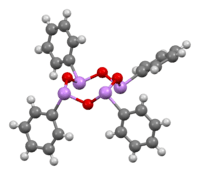Phenylarsine oxide
| Names | |
|---|---|
| IUPAC name
Oxo(phenyl)arsine | |
| Other names
Phenyl arsenoxide; Oxo(phenyl)arsane | |
| Identifiers | |
| 637-03-6 | |
| 3D model (Jmol) | Interactive image |
| ECHA InfoCard | 100.010.251 |
| |
| Properties | |
| C6H5AsO | |
| Molar mass | 168.03 g·mol−1 |
| Except where otherwise noted, data are given for materials in their standard state (at 25 °C [77 °F], 100 kPa). | |
| Infobox references | |
Phenylarsine oxide (PAO or PhAsO) in an organometallic compound with the empirical formula C6H5AsO. It contains a phenyl group and an oxygen atom both bonded to an arsenic atom.
Structure
Despite its simple empirical formula, phenylarsine oxide does not contain an As=O double bond. In common with other compounds with the general formula RAsO, PhAsO forms a cyclic oligomer.[1] A range of ring sizes are possible, but PhAsO crystallizes as the tetramer, cyclo-(PhAsO)4.[2] RAsO compounds form these species because for heavy elements such as arsenic, two single bonds to oxygen are more stable than one double bond; see double bond rule for details.
 |
 |
| Skeletal formula of cyclo-(PhAsO)4 | Molecular structure in the crystalline state |
Use in biochemical research
The arsenic atom in PAO has a high affinity for the sulfur atom of thiols in organic compounds, in particular, forming stable complexes with vicinal cysteine residues in protein structures. This effect makes it useful for studying ligand–receptor binding[3][4] This binding affinity also makes PAO useful for affinity chromatography by immobilizing it on a resin. It has a high selectivity for structures with vicinal cysteines rather than single cysteine residues[5] or cystine (a disulfide-bridged pair of cysteine residues).[6]
References
- ↑ Greenwood, Norman N.; Earnshaw, Alan (1997). Chemistry of the Elements (2nd ed.). Butterworth-Heinemann. p. 594. ISBN 0-08-037941-9.
- ↑ Müller, I. M.; Mühle, J. (1999). "Struktur und Koordinationsverhalten des sterisch anspruchsvollen Phenylcycloarsoxans". Z. anorg. allg. Chem. 625: 336–340. doi:10.1002/(SICI)1521-3749(199902)625:2<336::AID-ZAAC336>3.0.CO;2-6.
- ↑ Verspohl, EJ (2006). "Effect of PAO (phenylarsine oxide) on the inhibitory effect of insulin and IGF-1 on insulin release from INS-1 cells". Endocr J. 53 (1): 21–26. doi:10.1507/endocrj.53.21. PMID 16543668.
- ↑ Gerhard, R; John, H; Aktories, K; Just, I (2003). "Thiol-modifying phenylarsine oxide inhibits guanine nucleotide binding of Rho but not of Rac GTPases". Mol Pharmacol. 63 (6): 1349–1355. doi:10.1124/mol.63.6.1349. PMID 12761345.
- ↑ Shi, W; Dong, J; Scott, RA; Ksenzenko, MY; Rosen, BP (1996). "The role of arsenic-thiol interactions in metalloregulation of the ars operon". J Biol Chem. 271 (16): 9291–9297. doi:10.1074/jbc.271.16.9291. PMID 8621591.
- ↑ Foley, TD; Stredny, CM; Coppa, TM; Gubbiotti, MA (2010). "An improved phenylarsine oxide-affinity method identifies triose phosphate isomerase as a candidate redox receptor protein". Neurochem Res. 35 (2): 306–314. doi:10.1007/s11064-009-0056-z. PMID 19731017.